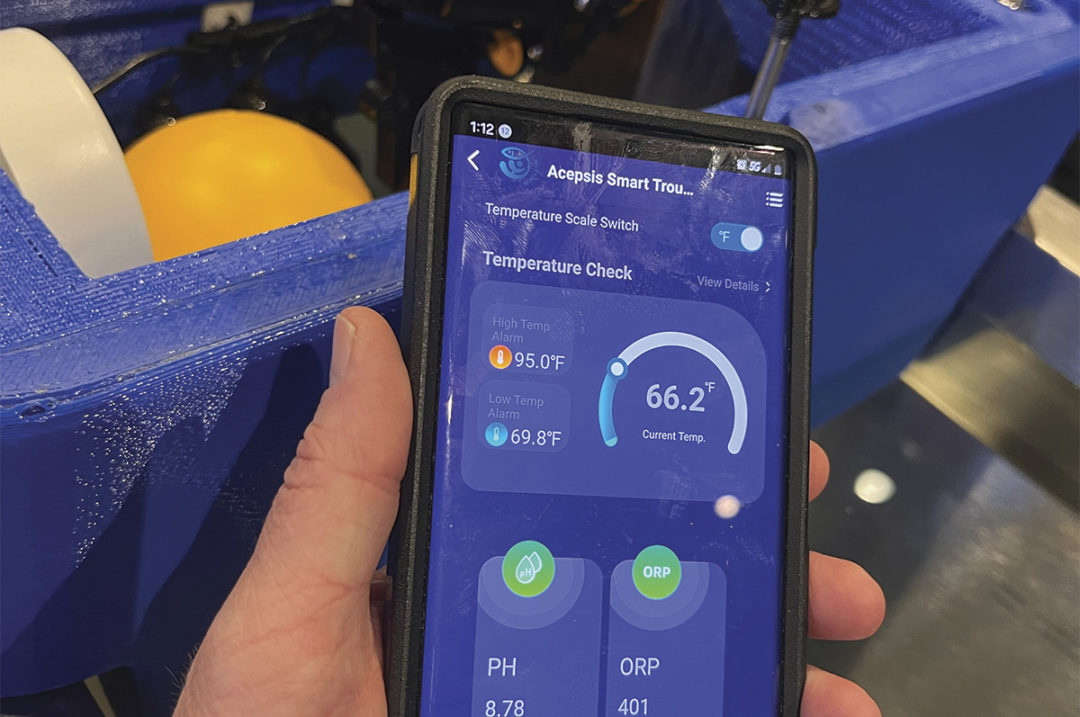A Wisconsin-based company aims to help dairies improve herd health and milk production with a new technology that levels up the usefulness of on-farm water troughs. Traditional water troughs can be hard to keep clean and can quickly become contaminated. What makes the new trough from Acepsis unique is its patent-pending design, monitoring tools and connected technology. These advancements lead to clearer water troughs, the company claims.
For starters, the unique design keeps the trough from becoming an easy method of disease transfer.
“We're trying to treat a farm’s water to eliminate pathogens,” says Dr. Dave Kolb, a practicing veterinarian and co-founder of Acepsis. “However, you can't disinfect organic matter or manure. You have to get rid of those organics in a water trough in order for any effective hygiene program to work. This is our solution for that problem.”
On cattle operations, water troughs can be collection points for feed residues, bedding material and manure. The presence of these organic materials in water increases the speed at which bacteria and biofilm grow and accumulate. The company’s new trough design eliminates organic materials with minimal water usage before they inhibit cleanliness.
The stainless-steel, sloped sides of the trough lead to a channel in the bottom of the trough. Above that channel is a rotating baffle plate. When open (the plate remains in a vertical position), organic debris can slide down the sidewalls, past the plate and into the channel. And when the baffle plate is closed (rotated horizontally and parallel with the channel), the trough will automatically initiate a flush to clear out the organic material resting in the channel and begin refilling. The current design requires the baffle plate to be manually closed with a lever to initiate the eight- to 10-second flush.
Regular flushing of organic material enables the trough and trough water to be effectively treated and sanitized continuously, the company claims. It also sells a chlorine dioxide water treatment system to maintain hygienic drinking water conditions.
“Our company is focused on hygiene,” Kolb says. “We feel like hygiene is an important part of animal husbandry.”
The company has been active promoting the importance of water hygiene during the recent highly pathogenic avian influenza (HPAI) and bovine influenza avian virus (BIAV) outbreak in the U.S. Sick cows not isolated from the herd could easily pass the virus on to other cows via unclean or untreated water troughs, the company says.
As the company has rolled out their new technology, they are teaching dairy producers to monitor the oxidation reduction potential (ORP) of their trough water. The oxygenating capacity of water correlates to how clean the water is. A high ORP value means the trough is naturally able to fend off becoming a growth medium for biofilm and pathogens. When organic matter is present in water, the ORP value of water declines significantly.
ORP values can be measured with a relatively cheap, mobile digital ORP sensor that looks like an oversized thermometer. Or in the case of the company’s new technology, one is built into the trough’s hardware. In addition, the smart trough comes with other monitoring equipment to track and report water temperature, water pH and water volume consumed.
“Water is the ultimate macronutrient. It's one of the biggest nutrients that cows consume. And we don't pay a lot of attention to it,” Kolb says. “We pay a lot of our attention to what we're feeding cows but not necessarily what they're drinking. And we'd like to change that whole philosophy a little bit.”
Data are transferred from the troughs via a Wi-Fi connection. Seeing the data could help dairies better understand their cows’ drinking water, giving producers an unprecedented window into their herd’s drinking habits.
“We’ve been surprised by the data we’re getting,” Kolb says.
For example, Kolb says on one pilot farm, the dairy observed that cows didn’t drink much from the waterers in the return lanes from the parlors like they thought was important. The same dairy also observed that the cows preferred to drink from water troughs between pen lanes and not at troughs at the end of pen lanes. The new technology’s monitoring capabilities allow producers to optimize water trough locations based on where cows prefer to drink. Kolb says believes the early data they have seen, if further validated, could debunk some long-held assumptions about where cows prefer to drink.
“Milk is 87 percent water,” Kolb says. “As an industry, we have spent a lot of time just sampling water quality at the source, the well, pond or stream. In reality, we should be looking at the water trough. That’s the water that cows are consuming and sharing disease pathogens with their trough mates.”
Acepsis has several pilots of its new smart water troughs on dairies now and will be making them commercially available this fall.
Did you know?
Cows drink between 30 and 50 gallons of water per day! They drink more per bodyweight than humans. If a human were to drink as much per pound of bodyweight as a cow, they would need to drink almost 5 gallons of water per day. The average human today drinks under a gallon of water per day.











